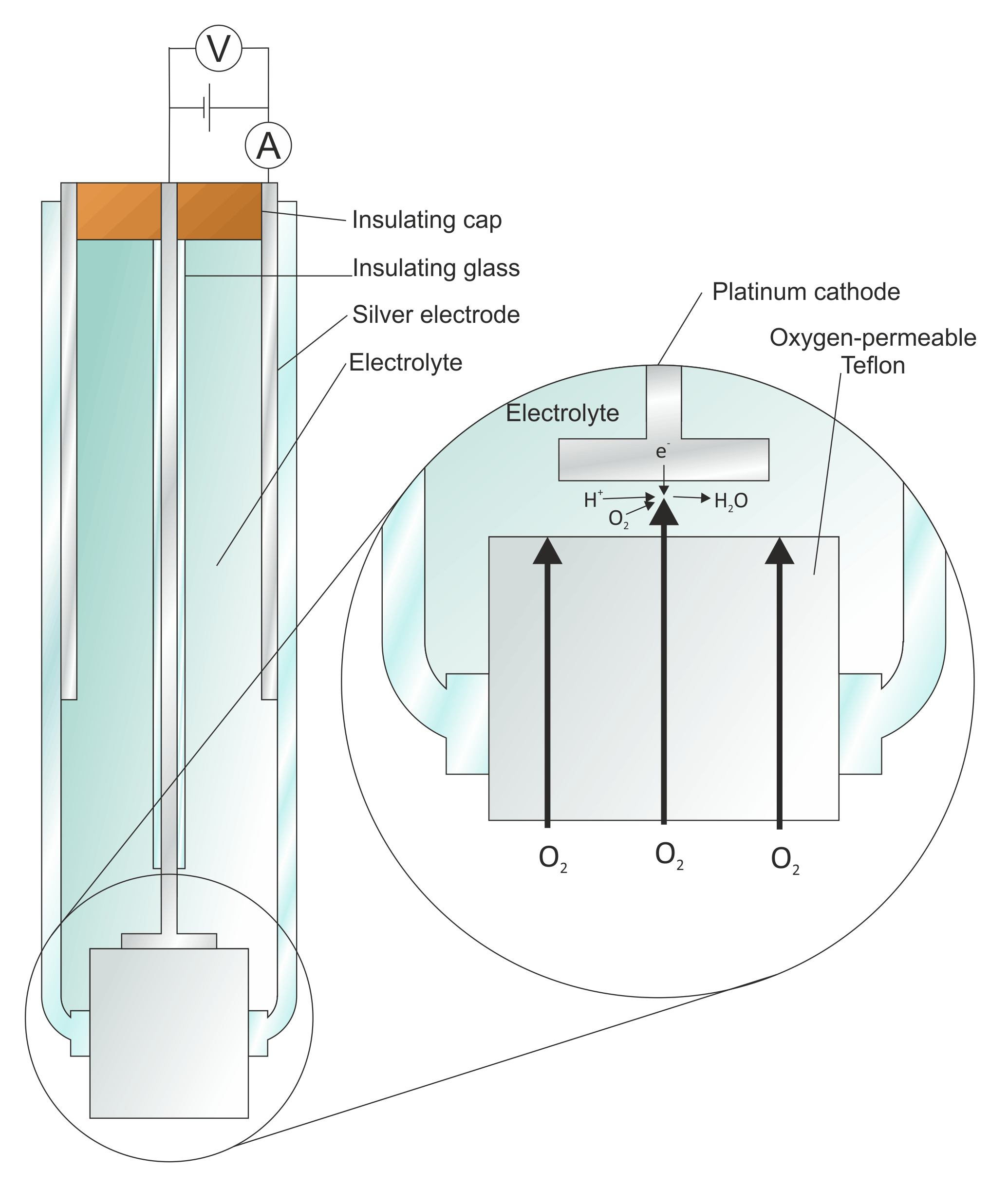Clark Electrode on:
[Wikipedia]
[Google]
[Amazon]
 The Clark electrode is an
The Clark electrode is an
Clark-type Sensors Explained
The Gas Detector Encyclopedia, Edaphic Scientific Knowledge Base
Clark Oxygen Electrode, precursor to today's modern biosensors
- broken link {{DEFAULTSORT:Clark Electrode Electrodes Gas sensors
 The Clark electrode is an
The Clark electrode is an electrode
An electrode is an electrical conductor used to make contact with a nonmetallic part of a circuit (e.g. a semiconductor, an electrolyte, a vacuum or air). Electrodes are essential parts of batteries that can consist of a variety of materials de ...
that measures ambient oxygen
Oxygen is the chemical element with the symbol O and atomic number 8. It is a member of the chalcogen group in the periodic table, a highly reactive nonmetal, and an oxidizing agent that readily forms oxides with most elements as wel ...
partial pressure in a liquid using a catalytic platinum
Platinum is a chemical element with the symbol Pt and atomic number 78. It is a dense, malleable, ductile, highly unreactive, precious, silverish-white transition metal. Its name originates from Spanish , a diminutive of "silver".
Platinu ...
surface according to the net reaction:
: O2 + 4 e− + 4 H+ → 2 H2O
It improves on a bare platinum electrode by use of a membrane to reduce fouling and metal plating onto the platinum.
History
Leland Clark
Leland C. Clark Jr. (December 4, 1918 – September 25, 2005) was an American biochemist born in Rochester, New York. He is most well known as the inventor of the Clark electrode, a device used for measuring oxygen in blood, water and other liquid ...
(Professor of Chemistry, Antioch College
Antioch College is a private liberal arts college in Yellow Springs, Ohio. Founded in 1850 by the Christian Connection, the college began operating in 1852 as a non-sectarian institution; politician and education reformer Horace Mann was its f ...
, Yellow Springs, Ohio
Yellow Springs is a village in Greene County, Ohio, United States. The population was 3,697 at the 2020 census. It is part of the Dayton Metropolitan Statistical Area. It is home to Antioch College.
History
The area of the village had long b ...
, and Fels Research Institute, Yellow Springs, Ohio) had developed the first bubble oxygenator for use in cardiac surgery. However, when he came to publish his results, his article was refused by the editor since the oxygen tension in the blood coming out from the device could not be measured. This motivated Clark to develop the oxygen electrode.
The electrode, when implanted in vivo, will reduce
Reduction, reduced, or reduce may refer to:
Science and technology Chemistry
* Reduction (chemistry), part of a reduction-oxidation (redox) reaction in which atoms have their oxidation state changed.
** Organic redox reaction, a redox react ...
oxygen and thus required stirring in order to maintain an equilibrium with the environment. Severinghaus improved the design by adding a stirred cuvette in a thermostat. A discrepancy between the measured partial pressure of oxygen (pO2) between blood samples and gaseous mixtures of identical pO2, meant that the modified electrode required calibration; consequently a microtonometer was added to the water thermostat.
Mechanism of action
The electrode compartment is isolated from the reaction chamber by a thinTeflon
Polytetrafluoroethylene (PTFE) is a synthetic fluoropolymer of tetrafluoroethylene that has numerous applications. It is one of the best-known and widely applied PFAS. The commonly known brand name of PTFE-based composition is Teflon by Chemou ...
membrane
A membrane is a selective barrier; it allows some things to pass through but stops others. Such things may be molecules, ions, or other small particles. Membranes can be generally classified into synthetic membranes and biological membranes. B ...
; the membrane is permeable to molecular oxygen and allows this gas to reach the cathode, where it is electrolytically reduced.
The above reaction requires a steady stream of electrons to the cathode, which depends on the rate at which oxygen can reach the electrode surface. Increasing the voltage applied (between the Pt electrode and a second Ag electrode) will increase the rate of electrocatalysis. Clark affixed an oxygen permselective membrane over the Pt electrode. This limits the diffusion rate of oxygen to the Pt electrode.
Above a certain voltage, the current plateaus and increasing the potential any further does not result in a higher rate of electrocatalysis of the reaction. At this point, the reaction is diffusion-limited and depends only on the permeability properties of the membrane (which is ideally well characterized, the electrode being calibrated against known standard solutions) and by the oxygen gas concentration, which is the measured quantity.
Applications
The Clark oxygen electrode laid the basis for the first glucose biosensor (in fact the first biosensor of any type), invented by Clark and Lyons in 1962. This sensor used a single Clark oxygen electrode coupled with a counter-electrode. As with the Clark electrode, a permselective membrane covers the Pt electrode. Now, however, the membrane is impregnated with immobilizedglucose oxidase
The glucose oxidase enzyme (GOx or GOD) also known as notatin (EC number 1.1.3.4) is an oxidoreductase that catalyses the oxidation of glucose to hydrogen peroxide and D-glucono-δ-lactone. This enzyme is produced by certain species of fungi and ...
(GOx). The GOx will consume some of the oxygen as it diffuses towards the PT electrode, incorporating it into H2O2 and gluconic acid. The rate of reaction current is limited by the diffusion of both glucose and oxygen. This diffusion can be well characterized for a membrane for both the oxygen and glucose, leaving as the only variable the oxygen and glucose concentrations on the analyte-side of the glucose membrane, which is the quantity being measured.
References
External links
Clark-type Sensors Explained
The Gas Detector Encyclopedia, Edaphic Scientific Knowledge Base
Clark Oxygen Electrode, precursor to today's modern biosensors
- broken link {{DEFAULTSORT:Clark Electrode Electrodes Gas sensors